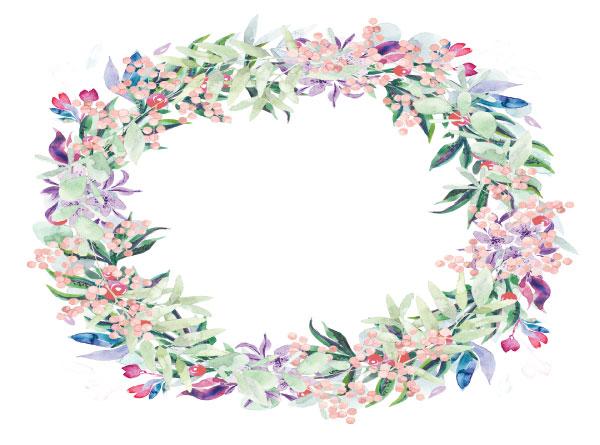
From every corner of the planet, very few unique and rare flowers have managed to attract the curiosity and interest of botanists and horticulturists alike. These exotic and expensive flowers cover all types of flora imaginable, providing a glimpse into just how distinctive the various paths of evolution can be. From the Black Bat Flower to the Kokia Cookei, here are some rare flowers that are stunning to look at.
Saffron Crocus
Saffron is a delicious and colourful seasoning that is used in breads, desserts, and main dishes in many parts of the world, from England to India, from the Middle East to Scandinavia, and all around the Mediterranean. Without it, an Indian curry or Spanish paella just wouldn’t be the same. The bright red-orange threads you get when you buy saffron are actually the stigmas, or female portion, of the Saffron Crocus flowers. It takes hundreds of flowers to produce a commercially useful amount, which explains why saffron is so expensive.
An areas where Saffron Crocus are reliably hardy-USDA Zone 6 through 8 in the South, 6 through 9 in the West-you should plant the corms as soon as you receive them. Saffron Crocus does best in full sun and well-drained soil that is moderately rich in organic matter. Ideally, the site should be relatively dry in summer, when the corms are dormant.
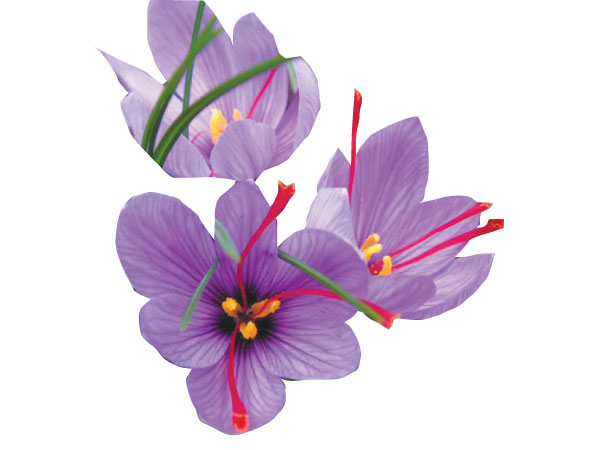
Overwintering Corms in Cold Climates:
Saffron Crocus can be grown in areas with colder winters than Zone 6, but the corms must be lifted and brought indoors for the winter. After the first few frosts, but before the ground has frozen solid, carefully dig out the corms, place them in a wooden crate or plastic tub, and completely cover with dry peat moss or sand.
Harvesting and Using Saffron: Three stigmas are borne in the centre of each purple, cup-shaped bloom. The best time to harvest the stigmas is mid-morning on a sunny day when the flowers have fully opened and are still fresh. Carefully pluck the stigmas from the flowers with your fingers, and then dry them in a warm place to preserve them for cooking. To use saffron, steep the threads in hot liquid (water, broth, or milk, depending on the
recipe) for about 20 minutes. Add both the threads and the steeping liquid early in the cooking or baking process, and the threads will continue to release their colour and flavour.
Black Bat flower
Tacca chantrieri, the black bat flower, is a species of flowering plant in the yam family Dioscoreaceae. Tacca chantrieri is an unusual plant in that it has black flowers.
These flowers are somewhat bat-shaped, are up to 12 inches across, and have long ‘whiskers’ that can grow up to 28 inches. There are ten species in the genus Tacca. One of these, T. integrifolia, is commonly called the “white bat plant.” T. integrifolia is similar to T. chantrieri, but has white bracts which are veined purple. T. integrifolia is larger than T. chantrieri, reaching up to four feet in height (almost twice the size of T. chantrieri at a height of 24”-36”).
Tacca chantrierei is native to tropical regions of Southeast Asia including Thailand, Malaysia, and southern China:
particularly Yunnan Province. They are under story plants, so they prefer shade (at least 60%). They grow best in well-drained soil with good air circulation, but they prefer high humidity, and need a lot of water.
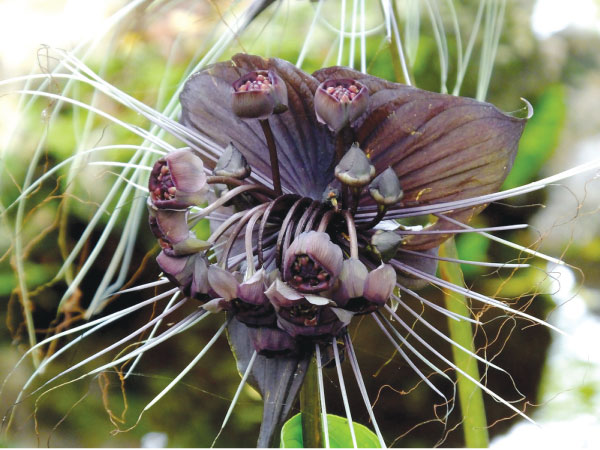
Corpse flower
Amorphophallus titanum, known as the titan arum, is a flowering plant with the largest unbranched inflorescence in the world.
Due to its odour, which is like the smell of a rotting animal, the titan arum is characterised as a carrion flower, and is also known as the corpse flower, or corpse plant. For the same reason, the title corpse flower is also attributed to the genus Rafflesia which, like the titan arum, grows in the rainforests of Sumatra, Indonesia.
The titan arum’s inflorescence can reach over 3 metres in height. Like the related cuckoo pint and calla lily, it consists of a fragrant spadix of flowers wrapped by a spathe, which looks like a large petal. In the case of the titanarum, the spathe is a deep green on the outside and dark burgundy red on the inside, with a deeply furrowed texture.
The spadix is hollow and resembles a large loaf of French bread.
Near the bottom of the spadix, hidden from view inside the sheath of the spathe, the spadix bears two rings of small flowers. The upper ring bears the male flowers; the lower ring is spangled with bright red-orange carpels. The “fragrance” of the titan arum resembles rotting meat, attracting carrion-eating beetles and flesh flies that pollinate it.
Both male and female flowers grow in the same inflorescence.
The female flowers open first, then a day or two following, the male flowers open. This usually prevents the flower from self-pollinating.
Afer the flower dies back, a single leaf, which reaches the size of a small tree, grows from the underground corm.
The leaf grows on a somewhat green stalk those branches into three sections at the top, each containing many leaflets. The leaf structure can reach up to 6 metres tall and 5 metres across. Each year, the old leaf dies and a new one grows in its place. When the corm has stored enough energy, it becomes dormant for about four months. Then, the process repeats.
In cultivation, the titan arum generally requires 7–10 years of vegetative growth before blooming for the first time.
After its initial blooming, there can be considerable variation in blooming frequency.
Some plants may not bloom again for another 7–10 years while others may bloom every two to three years.
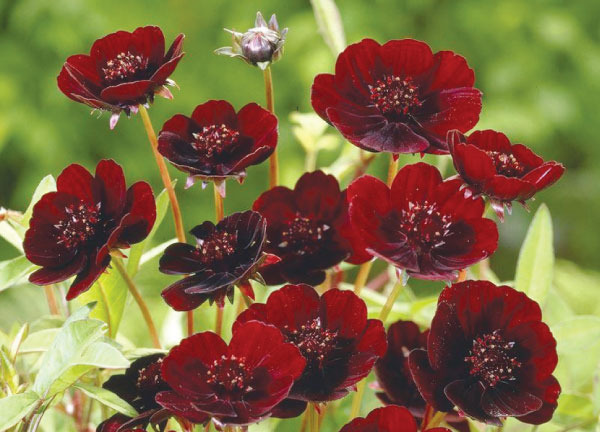
Chocolate Cosmos
Cosmos atrosanguineus (Chocolate Cosmos) is a species of Cosmos, native to Mexico, where it is extinct in the wild. The species was introduced into cultivation in 1902, where it survives as a single clone reproduced by vegetative propagation.
Cosmos atrosanguineus is a herbaceous perennial plant growing to 40–60 cm tall, with a fleshy tuberous root.
The leaves are 7–15 cm long, pinnate, with leaflets 2–5 cm long.
The flowers are produced in a capitulum 3-4.5 cm diametre, dark red to maroon dark brown, with a ring of six to ten broad ray florets and a centre of disc florets; they have a light vanillin fragrance, which becomes more noticeable as the summer day wears on.
The single surviving clone is a popular ornamental plant, grown for its rich dark red-brown flowers. It is not self-fertile, so no viable seeds are produced, and the plant has to be propagated by division of the tubers, or by tissueculture.
Noteworthy Characteristics: Chocolate fragrance; dark, almost black flowers over a long period; good cut flower.
Care: Grow in moist but well-drained, fertile soil in full sun. Deadhead and provide support. Mulch in autumn where hardy, or lift the tubers and keep frost-free during winter, storing them in barely moist peat.
Propaga on: Root basal cuttings with bottom heat in early spring.
Lotus wine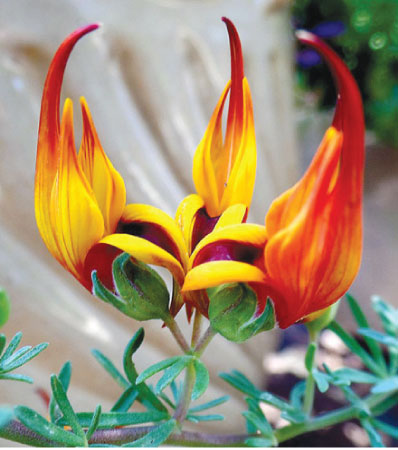
Lotus vine’s exotic looking flower is spectacular, resembling a parrot’s beak. Flame colour flowers in shades of red and golden yelloware perfectly suited to planter boxes, hanging baskets, window boxes, and decora_ve containers.
Don’t plant lotus vine solely for the flowers, as this plant is highly sought after for its unusual, needle-like foliage and bushy but trailing growth habit. Lotus vine pairs well with purple and yellow flowering plants, and chartreuse or bronze-leaved foliage plants.
Lotus vine can grow up to 3 feet in length by the end of the season. It has many-branched segments covered with very fine, gray-green leaves. In sun, they’re almost iridescent. The blossoms that appear in June or early July are up to 1 inch long with curvedpetals. They’re scarlet to crimson, lightening to an orange-red as they fade.
LOTUS VINE, Gold Flash: The golden yellow flowers tinged with orange look like small flames or parrots beak. It shows early and thrives in sunny locations. A must have in baskets and planters.
LOTUS VINE, Red Flash:
Red Flash has scarlet red flowers that resemble parrots beaks. The texture of the delicate foliage will soften the look of any planting. The exotic fire red flame coloured blooms show early and thrives in sunny locations. A must have in baskets and planters.
